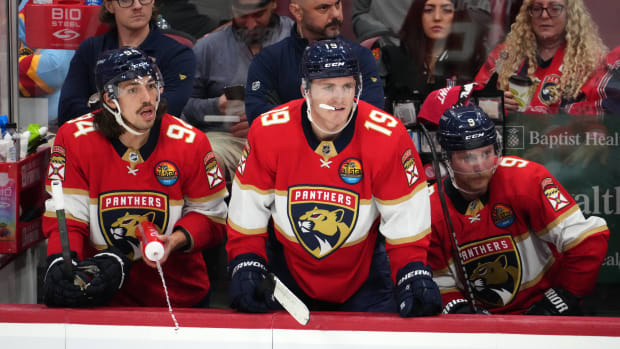Discipline isn’t just what the NHL does to deal with individual NHL players who’ve run afoul of the league’s laws. It’s also a big factor in winning games. Just look at team records this year and understand how an inability to stay out of the penalty box can influence a team’s place in the standings.
For instance: the Florida Panthers have 83 minor penalties this season. That’s six more minors than the second-place teams (Minnesota and Los Angeles) have taken this year.
It would be one thing if the Panthers’ penalty-killing unit was elite, but their PK is 16th overall, with a success rate of only 78.5 percent. It is no coincidence, then, that Florida is 15th in the standings.
If you’re looking to blame individual players, you can point to Panthers forwards Matthew Tkachuk and Sam Bennett, who rank third and second overall, respectively, in minors. Panthers D-man Radko Gudas isn’t far behind, with the fifth-most minors.
First-year Florida coach Paul Maurice knows how important their penalty kill is to the team’s overall success – in their most recent win – a 5-2 victory over Washington this past Tuesday – the Panthers were 5-for-5 on the PK.
“Penalty killing was the defining piece to our game,” Maurice told NHL.com. “Our power play goes 1-for-1, and we needed it, but we ran eight minutes of (penalty-killing) through the second period. We kind of took ourselves out of the rhythm with that. That’s fine, but you’ve kind of got most of your blue line gassed going into the third.
“The part of the game I enjoyed the most was the last six minutes because we got a huge (penalty) kill and then we’re right in those last five minutes.”
If your penalty-killing unit is thriving, you can take a few extra minors and not be hurt by them. The Dallas Stars are a good example of this: they’ve been shorthanded 70 times this year – the second-most in the league – but because their penalty kill is ranked fifth-overall at 82.9 percent, the Stars are the Central Division’s top team with a 10-5-2 record.
But if you can’t kill off penalties, it’s next to impossible to generate sufficient offense to overcome that inability.
Another example is the Edmonton Oilers’ play this season. They’re the NHL’s most-shorthanded team, with 71 PP opportunities for their opponents, but their penalty kill is 29th-overall at 71.8 percent success. Consequently, they’re 16th in the league standings.
There’s no question every team needs its goaltender to be one of the most-effective penalty-killers, and the Panthers and Oilers both have been let down to a degree by the lackluster performances of their netminders.
Florida starter Sergei Bobrovsky has a 3.47 goals-against average and .895 save percentage in 10 appearances, while Oilers No. 1 goalie Jack Campbell’s key individual numbers (4.28 GAA, .873 SP) in 10 games are even worse.
The defenders they play behind help determine goalie success, of course, but the best success would be staying out of the box, dominating the possession game and taking advantage of their power-play opportunities.
If teams can’t do that – especially veteran-laden teams like the Panthers and Oilers, who should know better – it’s a harbinger of bad days to come. We all know that minimizing mistakes is crucial for teams in the Stanley Cup playoffs, and that’s what minor penalties are. You can try blaming that on your perceived bias against on-ice officials, but that gets you nowhere. We’ve now seen enough of the regular season to have a decent sample size for everyone, and it’s on coaches like Maurice to ensure their team isn’t going to lose because one element of their special teams is failing miserably.
Franchises that succeed in hockey’s top league have to be good at many things, but team discipline is right up there with the most crucial attributes. If you’re leading the league in minors against your team, it’s not anybody’s fault but your own. And until you rectify that problem, you’re not going to wind up where you want to be.



